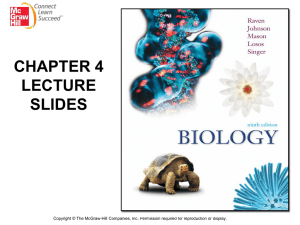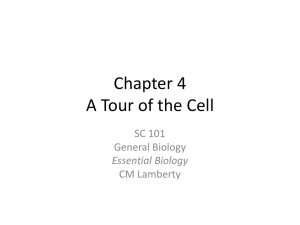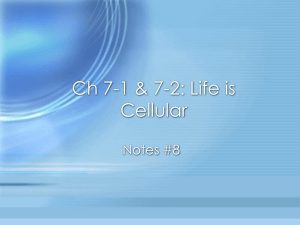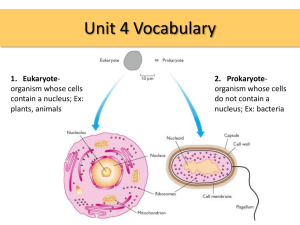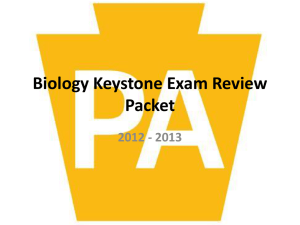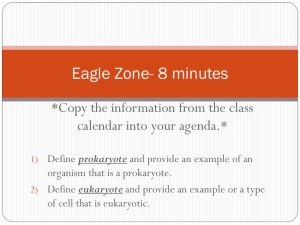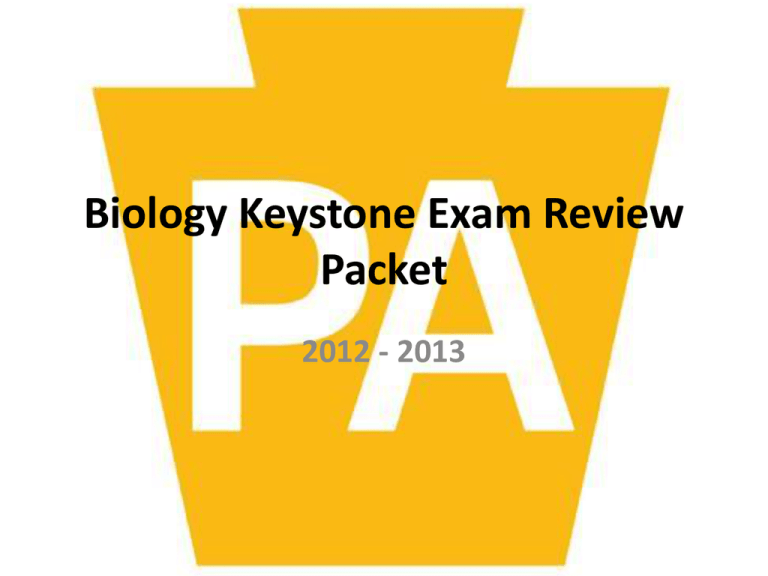
Biology Keystone Exam Review
Packet
2012 - 2013
1. Which characteristic is shared by all
prokaryotes and eukaryotes?
A.
B.
C.
D.
Ability to store hereditary information
Use of organelles to control cell processes
Use of cellular respiration for energy release
Ability to move in response to environmental
stimuli
All living things:
• Are made up of cells
• Have a universal genetic code
• Need a constant flow of energy
• Are capable of reproducing (on their own)
• Grow and Develop
• Have a level of organization (cells, tissue, organs,
organ systems, organism)
• Respond to Stimuli
2.
Living organisms can be classified as
prokaryotes or eukaryotes. Which two
structures are common to both
prokaryotic and eukaryotic cells?
A.
B.
C.
D.
Cell wall and nucleus
Cell wall and chloroplast
C. plasma membrane and nucleus
D. plasma membrane and cytoplasm
Prokaryotic vs Eukaryotic
Prokaryote
• Lack a nucleus and membrane
bound organelles
• Have cytoplasm, plasma (cell)
membrane, a cell wall, DNA and
ribosomes
• Bacteria and Archae
Eukaryotes
• Have membrane bound organelles
• Have a true nucleus with a nuclear
envelope
• Have a plasma membrane,
cytoplasm, DNA, ribosomes,
endoplasmic reticulum, golgi
apparatus, nucleolus w/i the
nucleus, vacuoles, a cell wall (in
some) and other organelles.
• Protists, Fungus, Plants, Animals
3. Prokaryotic cells are generally much
smaller than eukaryotic cells.
Part A: Identify a structural difference
between prokaryotic cells and eukaryotic
cells that is directly related to their
difference in size.
3. Prokaryotic cells are generally much
smaller than eukaryotic cells.
Part B: Based on structural difference,
explain why prokaryotic cells can be much
smaller than eukaryotic cells.
Prokaryotic cells lack membrane-bound organelles. Contain:
– Ribosomes
– DNA
Due to the lack of organelles, the total volume of the cell is smaller. Cells with organelles
(eukaryotic) have the ability to metabolize materials and retain a larger size.
No specialization of function due to a lack of organelles. Enzymes within the cytoplasm carry
out the metabolic functions of the cell
Eukaryotic cells contain membrane-bound organelles and organelles such as:
– Mitochondria
– Endoplasmic reticulum
– Vacuoles
– Lysosomes
– golgi apparatus
– Nucleus with DNA
– Nucleolus
– Ribosomes
Have a greater division of labor. Organelles are specialized.
Prokaryotic cells and eukaryotic cells both contain ribosomes, cytoplasm, a plasma membrane,
and genetic material
3.
Prokaryotic cells are generally much
smaller than eukaryotic cells.
Part C: Describe one Similarity between
prokaryotic cells and eukaryotic cells that
is independent of size.
• All cells contain:
– genetic information in the form of DNA
– ribosomes(cell organelles) that translate nucleic
acid (RNA) into protein
– a plasma membrane to create an internal
environment and allows for the movement of
materials from one side to another
4. Alveoli are microscopic air sacs in the lungs of
mammals. Which statement best describes how
the structure of the alveoli allows the lungs to
function properly?
A. They increase the amount of energy transferred
from the lungs to the blood>
B. They increase the flexibility of the lungs as they
expand during inhalation.
C. They increase the volume of the lungs, allowing
more oxygen to be inhaled.
D. They increase the surface area of the lungs,
allowing efficient gas exchange.
The Human Respiratory System
The alveoli increase surface
area for gas exchange
The membranes of the alveoli
are 1 cell thick. Oxygen and
Carbon dioxide can easily be
exchanged through the thin
walls.
Typical human has ~ 700 million
alveoli, accounting for an
area of ~70 m2 for gas
exchange
Alveoli
5. Which statement best describes an effect of the low
density of frozen water in a lake?
A. When water freezes, it contracts, decreasing the
water level in a lake.
B. Water in a lake freezes from the bottom up, killing
most aquatic organisms.
C. When water in a lake freezes, it floats, providing
insulation for organisms below.
D. Water removes thermal energy from the land around
a lake, causing the lake to freeze.
Properties of Water
1.
2.
3.
4.
Is a polar covalent molecule
Is the Universal solvent due to its
polarity. Polar covalent compounds
(like glucose) and ionic compounds
(like salt) can easily go into solution in
water.
Has a high specific heat. It is slow to
heat up and also slow to cool down.
This acts as an insulator in living
organisms since the majority of their
living tissue is water.
When water freezes, it expands and
therefore floats. Ice is less dense than
water. This provides an insulation to
the organisms in the water. The water
below will be at 4`C (if ice is above it)
6. Which statement correctly describes how
carbon’s ability to from four bonds makes
it uniquely suited to form macromolecules?
A. It forms short, simple carbon chains.
B. It forms large, complex, diverse molecules.
C. It forms covalent bonds with other carbon
atoms.
D. It forms covalent bonds that can exist in a single
plane.
Carbon
Methane
• Atomic number of 6.
– 2 electrons in the 1st orbital and 4 remaining in the
valance orbital.
– 4 unpaired will form 4 covalent bonds
• By bonding with other carbons in chains, rings,
single, double and triple bonds, carbon, it can
make all sorts of molecules
7.
Use the diagram below to answer the question.
Chemical Reaction
HO – 1 – 2 – 3 – H + HO – 4 - H
HO – 1 – 2 – 3 – 4 – H + H2O
The diagram shows a reaction that forms a polymer from two
monomers.
What is this type of reaction called?
A.
B.
C.
D.
Glycolysis
Hydrolysis
Photosynthesis
Dehydration synthesis
• This is dehydration synthesis. During this type of
reaction, a water molecule is removed (an –OH from
one simple monomer and an –H from another to form a
water molecule. This joins two monomers together to
form a polymer. When adding another monomer to the
dimer, another water molecule needs to be removed.
Monomer called Glucose
Dimer called Maltose
8. Carbohydrates and proteins are two types of macromolecules,
which functional characteristic of proteins distinguishes
them from carbohydrates?
1.
2.
3.
4.
Large amount of stored information
Ability to catalyze biochemical reactions
Efficient storage of usable chemical energy
Tendency to make cell membranes
hydrophobic.
Enzymes
Enzymes are proteins, which are biological catalysts.
•
They decrease activation energy, allowing a
chemical reaction to happen in an organism’s body at
a suitable temperature and time rate
• They enter into a reaction at an Active site to form an
Enzyme/Substrate complex
Proteins are a major part of every living cell and have many
different functions within each cell. Carbohydrates also perform
numerous roles in living things.
Part A: Describe the general composition of a protein molecule.
• A protein is a polymer of amino acids. When amino acids are
joined by dehydration synthesis (a process that removes water
to form a chemical bond), they form peptide bonds.
• There are three main components of an amino acid, shown
below.
A dipeptide formed by the removal of water
There are three main
components of an amino acid,
shown below.
Part B: Describe how the structures of proteins differ from the
structures of carbohydrates.
• Proteins are made up of the elements C,H,O,
and N while carbohydrates only contain C,H,
and O (elemental ratio of these three is 1:2:1)
• Carbohydrates do not contain peptide bonds
formed during dehydration synthesis (also
known as a condensation reaction)
Carbohydrate
Protein
Part C: Describe how the functions of proteins
differ from the functions of carbohydrates.
• Carbohydrates are our essential energy
molecules to be use almost immediately
(simple sugars like glucose) or stored in the
liver as glycogen.
• Proteins are building and regulatory
compounds (such as hormones and enzymes).
Muscles and cell membranes contain proteins
10.) Substance A is converted to substance B in a metabolic
reaction. Which statement best describes the
role of an enzyme during this reaction?
A.) It adjusts the pH of the reaction medium.
B.) It provides energy to carry out the reaction
C.) It dissolves substance A in the reaction
medium
D.) It speeds up the reaction without being
consumed.
• Enzymes are organic catalysts which regulate
the rate of a reaction. They allow reactions to
take place under conditions that will not
damage a cell.
• Enzymes are reusable. They do not break
down under normal conditions.
– Regulated by temperature, concentration and pH.
11.) A scientist observes that, when the pH of the environment
surrounding an enzyme is changed, the rate the enzyme
catalyzes a reaction greatly decreases. Which statement best
describes how a change in pH can affect an enzyme?
A. A pH change can cause the enzyme to change
its shape
B. A pH change can remove energy necessary to
activate an enzyme
C. A pH change can add new molecules to the
structure of the enzyme
D. A pH change can cause an enzyme to react
with a different substrate
Enzymes
• Think of an enzyme like a puzzle piece or a
key. If extreme heat is added to it, it will burn
or melt, changing its shape. The area where
the enzyme reacts with the substrate is called
the active site. If the active site is altered, it
can no longer function
• This change in shape is
called denaturing.
12.) Using a microscope, a student observes a small, green
organelle in a plant cell. Which energy transformation most
likely occurs first within the observed organelle?
A.) ATP to light
B.) light to chemical
C.) heat to electrical
D.) chemical to chemical
Photosynthesis
Is the process whereby organisms convert light energy
into chemical bond energy of glucose
• It occurs in the Chloroplasts of plant cells
Photosynthesis vs Respiration
• Think of Photosynthesis like baking a cake. The plant takes
raw material (CO2 and H20) and uses light energy to make
Glucose (and releases O2 in the process)
Respiration is the process whereby organisms break down
glucose to provide energy to all life processes
Breaks down glucose (sometimes with O2 and others without
it), transfers energy to a small energy transferring compound
called ATP
• Think of Respiration like burning the cake. Energy is released
from the bonds of glucose to be stored as ATP.
All plants (photosynthetic organisms) undergo both
Photosynthesis (only in the presence of light) and
Respiration (all of the time)
All living organisms must go through respiration 24/7
13.) Photosynthesis and cellular respiration are two
major processes of carbon cycling in living organisms.
Which statement correctly describes one similarity
between photosynthesis and cellular respiration?
A) Both occur in animal and plant cells.
B) Both include reactions that transform energy.
C) Both convert light energy into chemical energy.
D) Both synthesize organic molecules as end
products.—
14.) A protein in a cell membrane changed its
shape to move sodium and potassium ions
against their concentration gradients. Which
molecule was most likely used by the protein as
an energy source?
A) ATP
B) ADP
C) Catalase
D) Amylase
ATP – Temporary energy storage
molecule
ATP is a readily usable form of chemical energy.
By breaking off the 3rd phosphate (ATP =
adenosine triphosphate), energy is release to
allow reactions to happen, such as changing
the shape of a protein
15.) Use the diagrams below to answer the question.
Energy in
Energy in
Photosynthesis
Energy out
Respiration
Energy out
• Part A: Complete the chart below by
describing energy transformations involved in
each process.
Process
Energy Transformations
CO2 and H2O are transformed using the energy from sunlight
Photosynthesis to create C6H12O6 and O2. The captured and used energy is
stored in the chemical bonds of glucose (C6H12O6)
O2 and C6H12O6 are broken down with a small amount of
invested energy to form CO2 + H2O and a large amount of ATP
Cellular
Respiration which is the energy storage molecule of living things
Part B : Describe how energy transformations involved in
photosynthesis are related to energy
transformations involved in cellular respiration.
• They are, in essence, the reverse of each other.
The products of photosynthesis become the
reactants for cellular respiration, and the
opposite is true.
16.) Carbon dioxide and oxygen are molecules
that can move freely across a plasma
membrane. What determines the direction
that carbon dioxide and oxygen molecules
move?
A) Orientation of cholesterol in the plasma
membrane.
B) Concentration gradient across the plasma
membrane.
C) Configuration of phospholipids in the plasma
membrane.
D) Location of receptors on the surface of the
plasma membrane.
Transport through a membrane by
Diffusion
• Diffusion is the movement
of molecules from an area
of high concentration to
that of a lower
concentration
• If the concentration of
CO2 or O2 is too high on
one side of the
membrane, then the
molecules would not
freely be able to move
from an area of high
concentration to an area
of low concentration
17.) A sodium-potassium pump within a cell membrane
requires energy to move sodium and potassium ions into or
out of a cell. The movement of glucose into or out of a cell
does not require energy. Which statement best describes the
movement of these materials across a cell membrane?
A) Sodium and potassium ions move by active
transport, and glucose moves by osmosis.
B) Sodium and potassium ions move by active
transport, and glucose moves by facilitated
diffusion.
C) Sodium and potassium ions move by facilitated
diffusion, and glucose moves by osmosis.
D) Sodium and potassium ions move by facilitated
diffusion, and glucose moves by active transport.
Why B is correct
• Due to the fact that they are highly charged
molecules (and “hate” the nonpolar cell
membrane and can’t pass through it) and are
trying to move against a concentration
gradient (from low high), sodium and
potassium ions require a protein and energy to
move across the cell membrane. Glucose is a
large enough molecule (and polar), so it needs
the ‘help’ of a protein to move it along
(facilitated diffusion)
Types of Transport across a membrane
• Passive – by diffusion or
osmosis (if water)
– No energy is needed.
– Driven by concentration gradient
• Facilitated Diffusion –
movement across a membrane
with the help of carrier proteins.
– No energy is needed
– Still driven by the concentration
• Active transport – energy is
needed to go from an area of
low concentration to a more
concentrated area
18.) Some animals can produce a potassium ion concentration inside their cells that
is twenty times greater than that of their environment. This ion concentration
gradient is maintained by the plasma membrane
• Part A: Identify the process in the cell membrane that
produces this difference in concentration.
The process is active transport (needs energy).
• Part B: Explain the process that occurs as the cell produces
the ion concentration gradient.
There are specialized proteins in the cell membrane that act
like “pumps with a toll”. These pumps use ATP (small packets
of energy) to power their transport of Na+ out of a cell, and K+
into the cell. Because different numbers of sodium ions and
potassium ions are pumped back and forth, it creates an
electrical gradient where one side of the cell is more positive
than the other side
Sodium-Potassium Pump
Part C: Compare the process of potassium ion transport to
another mechanism that moves material across the plasma
membrane.
• Active transport is specific and also uses
energy, which is the key distinction, as
opposed to facilitated diffusion which is also
specific to a molecule (or ion) but does not
require energy. An example would be glucose
is too big to pass through the cell membrane
on its own, but can do so the with help of a
specific protein.
19.) The rough endoplasmic reticulum and Golgi
apparatus work together in eukaryotic cells.
What is one way that the rough endoplasmic
reticulum assists the Golgi apparatus?
1. It assembles nucleic acids from monomers.
2. It breaks down old damaged
macromolecules.
3. It packages new protein molecules into
vesicles.
4. It determines which protein molecules to
synthesize.
Protein Synthesis
Proteins are code for by genes on
DNA.
1. mRNA “reads” the gene and
carries the message to the
ribosomes either free in the
cytoplasm or attached to the
endoplasmic reticulum (Rough
1
endoplasmic reticulum if they
have ribosomes on them)
2. At the ribosomes on the RER,
DNA’s message gets uncoded
and Proteins are produced (with
the help of tRNA transfering
amino acids (the building units
of proteins) to the ribosomes
3. The proteins produced will be
transport to the Golgi apparatus
which will package the proteins
and
4. export proteins to the cell or
other cells.
2
4
3
20.) Which example is an activity that a fish most
likely uses to maintain homeostasis within its body?
A.) Using camouflage to avoid predators.
B.) Feeding at night to regulate body
temperature.
C.) Moving to deeper water to regulate
metabolic wastes
D.) Exchanging gases through its gills to regulate
oxygen levels.
• O2 is needed for cellular respiration to provide
energy for the organism. At the gills, O2 and
CO2 are exchanged. If CO2 is present, the
amount of O2 will change to stay regulated.
21.) Use the illustration below to answer the question.
Cell Division
Which statement best describes the phase of the cell cycle shown?
A. The cell is in prophase of mitosis because the number of chromosomes has doubled.
B. The cell is in prophase I of meiosis because the number if chromosomes has
doubled.
C. The cell is in telophase of mitosis because the cell is separating and contains two copies
of each chromosome.
D. The cell is in telophase of meiosis because the cell is separating and contains two copies
of each chromosome.
Cell Division (Mitosis)
Cell division results in two
identical daughter cells.
The process of cell divisions
occurs in three parts:
• Interphase - duplication of
chromosomes and
preparing the nucleus for
division
• Mitosis – organized division
of the nucleus into two
identical nuclei
• Cytokinesis- division of the
cell and cellular contents
into two identical daughter
cells
• Animation
22.) Mitosis and meiosis are processes by which animal and
plant cells divide. Which statement best describes a difference
between mitosis and meiosis?
A.
B.
C.
D.
Meiosis is a multi-step process.
Mitosis occurs only in eukaryotic cells.
Meiosis is used in the repair of an organism.
Mitosis produces genetically identical
daughter cells.
Meiosis
• Meiosis occurs during the
formation of sex cells (sperm
and egg). It is necessary so
that the sex cells only have
half the number of
chromosomes (23 in us) so
that at fertilization, the normal
chromosome number is
returned (46 in us)
• Meiosis involves two divisions.
It begins with the replication
of the chromosomes, divides
up the cell into two cells, then
divides again (without
replication) into 4 genetically
different sex cells with half the
normal number of
chromosomes
23.) Patau syndrome can be a lethal genetic disorder in mammals, resulting
from chromosomes failing to separate during meiosis.
• Part A: Identify the step during the process of meiosis
when chromosomes would most likely fail to separate.
• Most likely chromosomes would fair to separate during
anaphase I or Anaphase II. In anaphase, chromosomes
(anaphase I) or sister chromatids (anaphase II) are
supposed to separate, or move AWAY from each other. This
is called Nondisjunction.
• Part B: Describe how chromosome separation in meiosis is
different from chromosome separation in mitosis.
• During meiosis cells and the genetic material is divided
twice (the first set of division is meiosis I and the second set
is meiosis II). In mitosis, the cell and chromosomes divide
once.
Nondisjunction and Patau’s syndrome
Nondisjunction
Karyotype of a normal male
Karyotype of a Patau’s male (notice
chromosome #13 has three
chromosomes instead of two
Part C: Compare the effects of a disorder caused by chromosomes failing to
separate during meiosis, such as Patau syndrome, to the effects of
chromosomes failing to separate during mitosis.
• Due to the improper number of
chromosomes, the organism has an
improper amount of genetic material in
the form of DNA of the sperm or egg.
This mutation will be found in every cell
of the organism’s body.
• If chromosomes fail to separate during
mitosis, it does not affect the sex cells
but a body cell. This mutant body cell
then can be reproduced and produce
more of the abnormal cells. The cell
either dies or is replicated quickly. This
could possibly lead to cancer if the cells
are not destroyed by the immune
system.
24.) Which process helps to preserve the genetic information
stored in DNA during DNA replication?
A.) The replacement of nitrogen base thymine
with uracil.
B.) Enzymes quickly linking nitrogen bases with
hydrogen bonds.
C.) The synthesis of unique sugar and phosphate
molecules for each nucleotide.
D.) Nucleotides lining up along the template
strand according to base pairing rules.
DNA Replication
• This is key for DNA
replication. DNA (a double
stranded molecule) splits
into two halves, and each
half serves as a “template”
or pattern to build the new
half.
• The result is two identical
strands of DNA
– Adenine always pairs with
Thymine (straight line
letters AT go together) and
Guanine always pairs with
Cytosine (curvy letters GC
go together)
25.) In a flowering plant species, red flower color is dominant
over white flower color. What is the genotype of any
red-flowering plant resulting from this species?
A. Red and white alleles present on one
chromosome.
B. Red and white alleles present on two
chromosomes.
C. A red allele present on both homologous
chromosomes
D. A red allele present on at least one of two
homologous chromosomes.
Genetics
• Dominant traits are represented by capital letters,
while recessive (non-dominant traits) are represented
by lower case letters.
– Each parent has two copies of the gene, so they will get
two letters. The different letters represent the different
alleles (flower pedal color) of a trait.
– Since white is the recessive trait, in order to have white
petals, the flower has to be ff or pure for the white trait.
– Since red color is dominant, the red parent could be Ff or
FF since it shows red petals. It is either pure for the red
trait or a hybrid for red.
• When the dominant trait shows, only one allele (form
of the gene) must be present to show the trait.
26. Use the table below to answer the
question.
Genotype(s)
Phenotype
ii
O
IAIA, IAi
A
IBIB, IBi
B
IAIB
AB
Blood type is inherited through
multiple alleles, including IA, IB, and i.
A child has type A blood. If the father
has type AB blood, what are all the
possible phenotypes of the mother?
A.Phenotypes O or A
B.Phenotypes A or AB
C.Phenotypes A, B, or AB
D.Phenotypes O, A, B, or AB
Blood Type
• The father must give his IA allele or else the child would
not have type A
• The mother could be any of the blood types.
• If the mother is O she has ii, either of these could
produce a child with type A
• If the mother has A should could have the genotype IAi
or IAIA, if the child inherits i or IA it will have type A
• If the mother has B should could have the genotype IBi,
she could give the i allele and the child will have type A
blood.
• If the mother is AB she would have to give the IA allele
so the child will have type A
27. A cattle farmer genetically crosses a cow (female) with a
white coat with a bull (male) with a red coat. The resulting calf
(offspring) is roan, which means there are red and white hairs
intermixed in the coat of the calf. The genes for coat color in a
cattle are codominant.
• Part A: Although a farm has cattle in all three
colors, the farmer prefers roan cattle over white
or red cattle. Use the Punnett square to show a
cross that would produce only roan offspring.
• Part B: Explain how a roan calf results from one
white and one red coated parent. In your
explanation, use letters to represent genes. Be
sure to indicate what colors the letter represent.
• Part C: Predict the possible genotypes and
phenotypes of the offspring produced from two
roan cattle.
Codominant Inheritance
Part A
R
R
R’
RR’
RR’
R’
RR’
RR’
Part B:
In cattle, R is the red allele and R’ is the white allele. Since
this is a codominant trait, when both alleles are present, both
are expressed in the phenotype, this makes the color roan. A
white cow must have the genotype R’R’ and a red bull must
have the genotype RR. Since each parent is homozygous,
they can only pass on one allele for red and one allele for
white, creating roan offspring.
Codominant Inheritance
Part C:
If you do a Punnett square, you will find 25% of
the offspring will be red, 50% will be roan, and
25% will be white.
R
R’
R
RR
RR’
R’
RR’
R’R’
28. Use the diagram below to answer the
question. Which type of change in chromosome
composition is illustrated in the diagram?
A.Deletion
B.Insertion
C.Inversion
D.Translocation
Chromosome Changes
• The chromosome change seen in this diagram
is translocation because a portion of DNA is
being swapped between two chromosomes.
29. Which statement describes a cell
process that is common to both eukaryotic
and prokaryotic cells?
A. Both cell types carry out transcription in the
nucleus
B. Both cell types use ribosomes to carry out
translation
C. Both cell types assemble amino acids to carry
out transcription
D. Both cell types carry out translation in the
endoplasmic reticulum
Transcription/Translation in Pro and Eu
Cells
• Prokarytic cells do not have a nucleus or other
membrane-bound organelles.
• Both eukaryotic and prokaryotic cells have
ribosomes that make proteins.
30. The endoplasmic reticulum is a network of membranes
within the cell, and it is often classified as rough or smooth,
depending on whether there are ribosomes on its surface.
Which statement best describes the role of rough endoplasmic
reticulum in the cell?
A. It stores all proteins for later use
B. It provides an attachment site for larger
organelles
C. It aids in the production of membrane and
secretory proteins
D. It stores amino acids required for the
production of all proteins
Rough ER and Ribosomes
• Ribosomes that are attached the rough ER
produce proteins that are destined to be
exported from the cell
• Proteins that can be found in the plasma
membrane are considered exports
• Free-floating ribosomes in the cytoplasm
produce proteins that are meant to stay and
be used inside the cell
31. A genetic mutation resulted in a change in the sequences of
amino acids of a protein, but the function of the protein was not
changed. Which statement best describes the genetic mutation?
A. It was a silent mutation that caused a change
in the DNA of the organism
B. It was a silent mutation that caused a change
in the phenotype of the organism
C. It was a nonsense mutation that caused a
change in the DNA of the organism
D. It was a nonsense mutation that caused a
change in the phenotype of the organism
DNA Mutations
• A nonsense mutation alters the DNA so that
the resulting amino acid sequence is
unrecognizable and may create a
nonfunctioning protein.
• A silent mutation alters the DNA so that the
amino acid sequence does not change or the
changed amino acid does little to affect the
overall protein structure.
32. Genetic engineering has led to genetically
modified plants that resist insect and bacterial
and fungal infections. Which outcome would
most likely be a reason why some scientists
recommend caution in planting genetically
modified plants?
A.
B.
C.
D.
Unplanned ecosystem interactions
Reduced pesticide and herbicide use
Improved agricultural yield and profit
Increased genetic variation and diversity
GMOs
• The biggest threat to using GMOs in agricultre
is the possible interactions the organism will
have with other organisms in the
environment. If the plant were to fertilize a
non-GMO plant, the genes could become part
of the environment and potentially upset the
ecosystem but preventing natural bacteria,
fungus, and insects from living where they
naturally occur (on plants)
33. Use the circle graphs below to answer the
question. The graphs illustrate change in a lizard
population over time. Which process most likely led to
the change in the lizard population?
A. natural selection for a trait that is
beneficial to lizards
B. natural selection against a trait
that is beneficial to lizards
C. artificial selection for a trait that
is beneficial to lizards
D. artificial selection against a trait
that is beneficial to lizards
Natural vs. Artificial Selection
• Artificial selection would be the selection for a
trait that is beneficial to humans, not
necessarily the organism we are breeding.
• Natural selection is the selection of a trait that
would lead to increased fitness of the
individual (the individual would survive longer
and be able to produce more offspring)
34. In North America, the eastern spotted skunk mates
in late winter, and the western spotted skunk mates in
late summer. Even though their geographic ranges
overlap, the species do not mate with each other.
What most likely prevents these two species from
interbreeding?
A.
B.
C.
D.
Habitat isolation
Gametic isolation
Geographic isolation
Reproductive isolation
Mechanisms for Speciation
• This is an example of reproductive isolation
because these two species are never given the
opportunity to produce offspring.
• They live in the same region and could
produce offspring if they were to mate at the
same time of the year.
35. A mutation occurs in the genes that
code for coat color in deer. Which change
will most likely result from this mutation?
A. A change in the selection pressures acting on
coat color.
B. A change in the coat-color genes of deer
predator species.
C. An increase in coat-color diversity in the
population.
D. An increase in the number of genes for coat
color in the population
Mutations
• From the wording of the question, you would
have to assume that coat color in deer in
controlled by only one gene.
• Genes can only control what the organisms
looks like, not what is the best fit for the
environment.
• Adding another coat color to the population
would increase the diversity
36. Use the illustration below to answer the question.
The skeletons of mammalian forelimbs represent
variations of a structure that was present in their
common ancestor. What has most likely caused the
variation in forelimbs?
A. Changes in muscle
structure
B. Changes in the genetic
codes
C. Trait formation due to
behaviors
D. Development of vestigial
structures
Forelimbs
• The similarity in structure of all the
mammalian forelimbs can be attributed to the
fact that we all evolved from a common
ancestor that had a similar forelimb structure.
• Over time, these structures may change in
order to best suit the environment the
organism is living in
37. Use the table below to answer the question. The gene COII
is the genome of many organisms. A comparison of the number
of base differences between the COII gene in a rat and that of
two other animals is shown.
• Part A: Based on the data, describe a possible
evolutionary relationship between rats, mice, and
cow.
• Part B: Describe how different organisms having
a common gene, such as COII, supports the
theory of evolution.
• Part C: The COII gene of a monkey has 203
base differences from the same gene in a rat
and 210 base differences from the same gene
in a mouse. Compare the evolutionary
relationships between the monkey, the rat and
the mouse.
Inferring Evolutionary Relationships
• Part A: The fewer the number of base differences, the
more closely related two organisms are. The mouse
and the rat have the fewest number of differences
(101), therefore they are more closely related to one
another than the rat is to the cow.
• Part B: The fact that many organisms use the same
protein suggests that we all are descendant from a
common ancestor. It would be highly unlikely that
different species evolved to use the same proteins to
carry out the same functions in the body unless they
shared a common ancestor. The common ancestor
used the COII protein and when it branched into other
species, those species continued using the protein.
Inferring Evolutionary Relationships
• Part C: The rat and the monkey have fewer
differences than the monkey and the mouse.
Therefore, the rat and the monkey are more
closely related than the mouse and the
monkey.
38. Use the table below to answer the question. A group of
students measured a ten-square-meter section of a pond
ecosystem and recorded observations. Which statement is a
testable hypothesis?
A. The frogs living in the pond represent a population
B. Water is an abiotic component in the pond ecosystem.
C. If the fish are given more food, then they will be happier.
D. If the frogs are startled, then they will jump into the water.
39. Use the list below to answer the question. A
student wrote several observation in a field notebook.
Which term best classifies all of the student’s
observations?
Observations
• Two grey wolves
• five moose
• several species of conifer trees
• large granite rock
• shallow pond
A.
B.
C.
D.
Population
Food chain
Ecosystem
community
Observations
• The addition of the granite rock and shallow
pond makes this list of living and nonliving
things.
• A population consists of only one species, a
food chain only includes living individuals, and
a community includes all living things.
40. A researcher observing an ecosystem describes the
amount of sunlight, precipitation, and type of
soil present. Which factors is the researcher most
likely describing?
A.
B.
C.
D.
biotic factors in a forest
biotic factors in a tundra
abiotic factors in a prairie
abiotic factors in an ocean
Biotic vs. Abiotic
• All the things being described are nonliving
(Abiotic)
• The addition of soil would indicate this
ecosystem is terrestrial (found on land)
• The only option that meets both these criteria
is a prairie
41. Use the diagram below to answer the
question. Which sequence correctly describes
the flow of energy between organisms in the
marine food web?
A. from seals to penguins to krill
B. from whales to drill to small fish
C. from sea birds to seals to
penguins
D. from small fish to penguins to seals
Food Webs
• The arrows on the food web indicate the
movement of the energy.
• The energy in a food web begins with the
primary consumer, in this case, krill.
• The correct sequence for this food web is from
small fish, to penguins, to seals.
42. A species of snapping turtles has a tongue that
resembles a worm. The tongue is used to attract small
fish. Which best describes the interaction
between the fish and the snapping turtle.
A.
B.
C.
D.
Predation
Symbiosis
Parasitism
Competition
Symbiosis
• Symbiosis describes any relationship between
two species.
• The turtle is using its tongue to attract small
fish in order to eat them. This is an example
of predation.
43. Which statement correctly
describes how nitrogen in the soil
returns to the atmosphere?
A. Soil bacteria convert into nitrogen gas.
B. Decomposers directly convert ammonium
into nitrogen gas.
C. Plants assimilate nitrites and convert them
into nitrogen gas.
D. Nitrogen-fixing bacteria in plant roots
convert nitrates into nitrogen gas.
Nitrogen Cycle
• If you recall the nitrogen cycle, only bacteria
can convert nitrogen gas to a useable form,
conversely, they are also the only organisms
that can return it to the atmosphere.
44. Agricultural runoff can carry fertilizers into lakes
and streams. This runoff can cause algae populations
to increase. Which effect does this change in the
algae population sizes most likely have on affected
lakes and streams?
A. an increase in water level
B. an increase in water clarity
C. a reduction in dissolved oxygen needed by
fish and shellfish
D. a reduction in temperature variations near
the water’s surface
Algal Blooms
• An increase in the algae population in a body
of water is referred to as an algal bloom.
• This is not good for the other organisms living
in that type of ecosystem. The water is
difficult to see through, and the algae use all
the dissolved oxygen so fish can no longer
breath
45. A farmer observed that an increase in a field’s soil nitrogen
content was followed by an increase in producer productivity.
What does this observation most likely indicate about the
relationship between nitrogen and the producers in the field?
A.
B.
C.
D.
Nitrogen was a biotic factor.
Nitrogen was a limiting factor.
Nitrogen became a surplus resource.
Nitrogen became a selection pressure.
46. Use the graph below to answer the question. Isle Royale is located in Lake
Superior. Isle Royale is home to populations of wolves and moose. The
interactions between the wolves and moose, as well as the individual
population sizes, have been studied since 1958. The graph shows the
population sizes over time for both wolves and moose.
• Part A: Describe one limiting factor for the moose population
• Part B: Explain one likely reason why the wolf population rapidly
increased between 1975 and 1980.
• Part C: Predict what will happen to the moose population's size
after 1994 by describing the shape of the curve. In your answer, be
sure to explain the reasoning behind your prediction.


